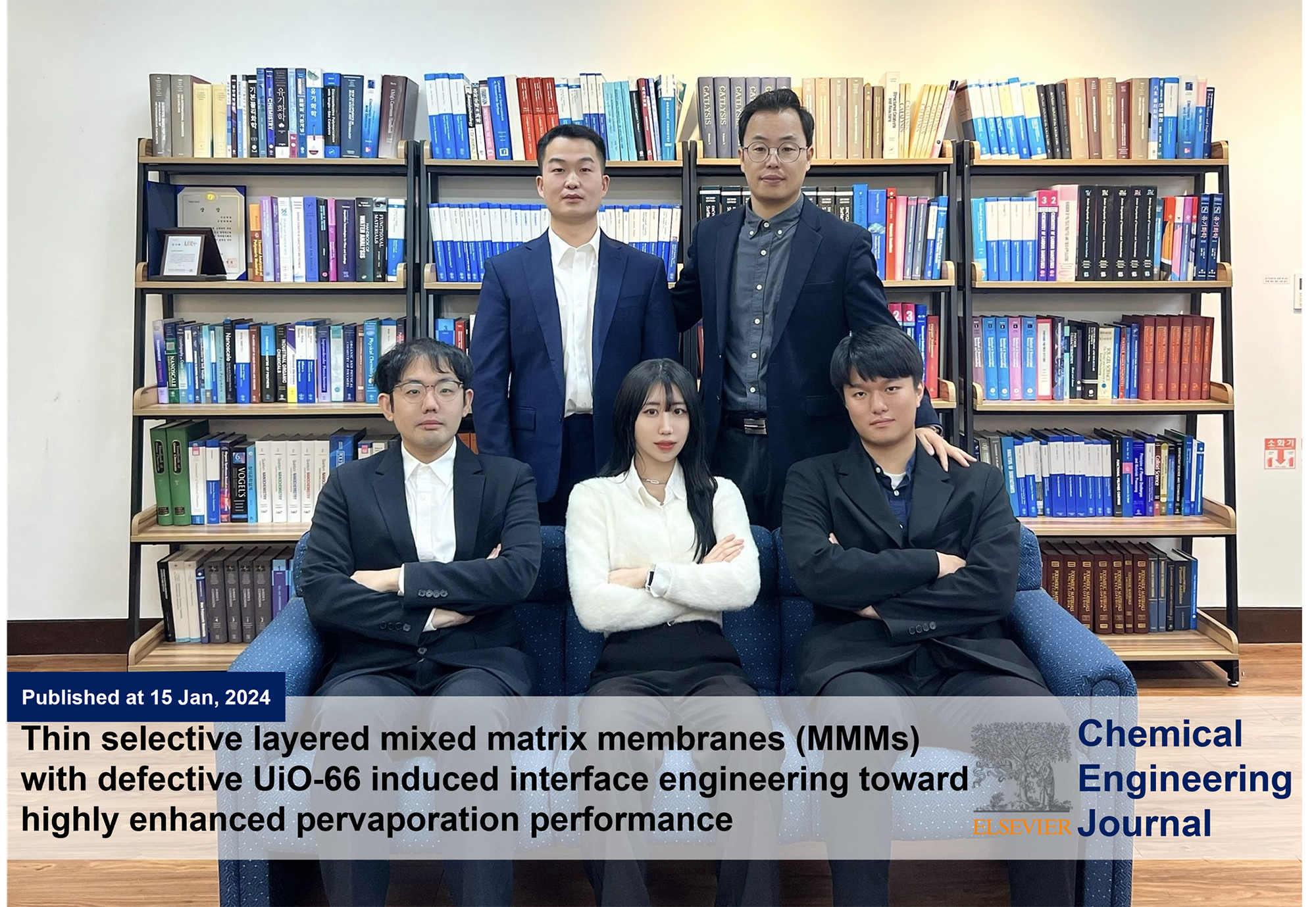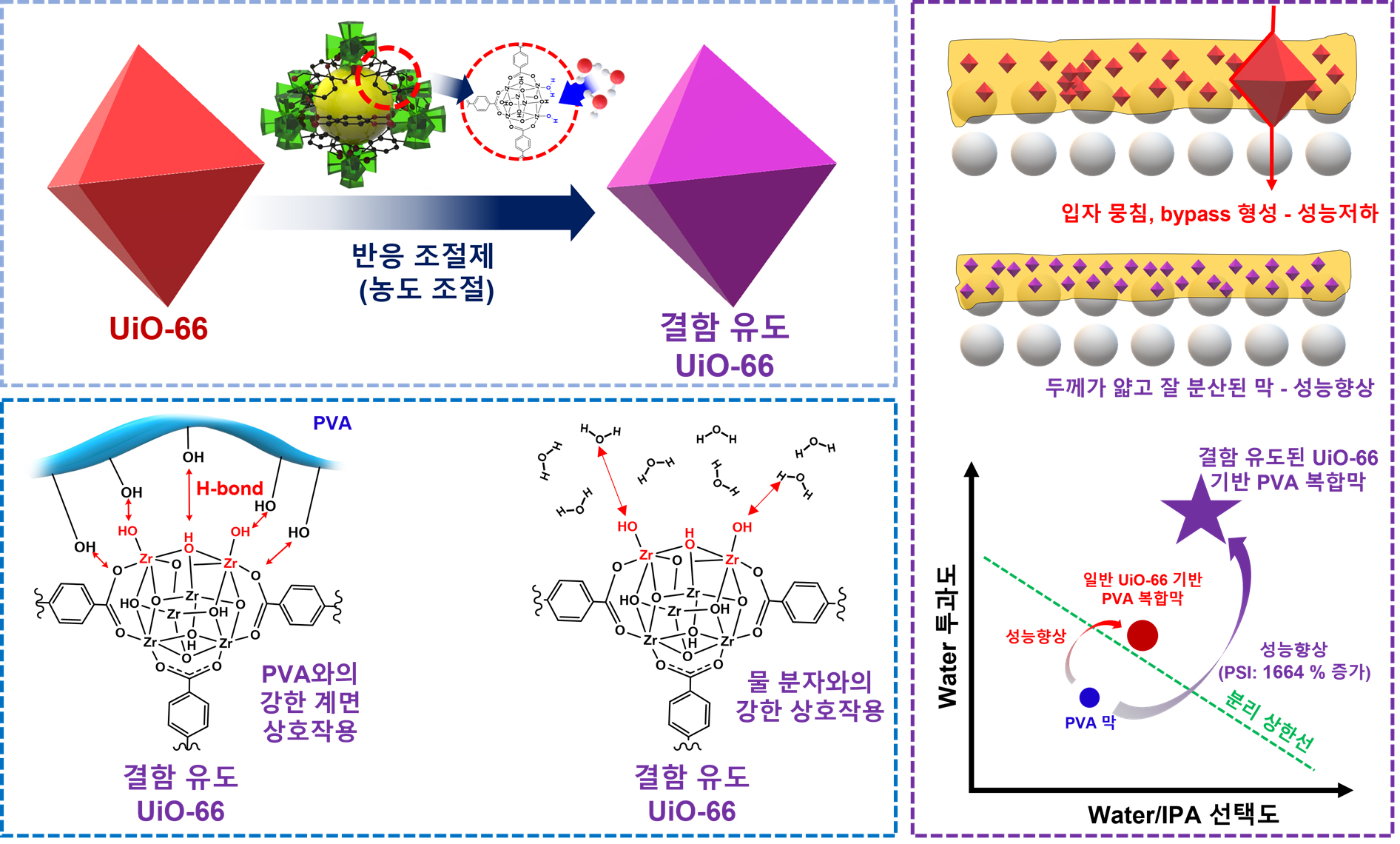커뮤니티
부경투데이
- 국립 부경대학교의 다양한 모습과 소식을 접하시면 부경대학교가 한번 더 가까워집니다.
| 고성능 복합막 개발 성공(Successfully developed a high-performance composite membrane) | |||
| 작성자 | 대외협력과 | 작성일 | 2024-02-16 |
| 조회수 | 401 | ||
| 고성능 복합막 개발 성공(Successfully developed a high-performance composite membrane) | |||||
 |
대외협력과 |  |
2024-02-16 |  |
401 |
국립부경대 조계용 교수팀, MOF 기반 고성능 복합막 개발
- 한국에너지기술연구원과 공동연구 성과 … 국제학술지 게재

△ 연구팀 사진(앞줄 왼쪽부터 권영제 박사과정생, 배지우 석사과정생, 최경민 석사과정생, 뒷줄 왼쪽부터 Kaiyun Zhang 석사과정생, 조계용 교수)
국립부경대학교 조계용 교수(공업화학전공) 연구팀은 금속 유기 골격체(MOF) 중 하나인 UiO-66 나노입자에 의도적으로 결함(Defects)을 유도하고, 이 결함이 복합막의 제조와 성능에 미치는 영향을 분석해 고성능 복합막을 개발하는 데 성공했다고 밝혔다.
조계용 교수는 같은 대학 권혁택 교수(화학공학전공), 손민영 교수(공업화학전공)와 한국에너지기술연구원 여정구 박사 연구팀과 진행한 공동연구를 통해 이번 연구 성과를 거뒀다.
금속-유기 골격체 소재는 금속과 유기물이 합성돼 만들어진 다공성, 결정성 입자로, 다양한 조합이 가능하고 높은 비표면적, 균일한 기공크기 및 높은 조정성 등의 독특한 특성으로 인해 촉매, 가스 분리 및 저장 등 다양한 분야에 활용하기 위한 연구가 활발히 진행되고 있다.
하지만 이 소재는 고분자 소재와의 상용성이 낮아 입자 뭉침 등으로 막 안정성 및 분리 성능이 크게 떨어지게 되는 단점이 있고, 이 소재로 복합막을 얇게 제조할 때 분리 구동 조건에 따라 형태 안정성이 낮아 박막 형태로 제조가 어려운 한계가 있었다.
조계용 교수 연구팀은 이러한 한계를 극복하기 위해 반응조절제(modulator) 등 반응물 농도 조절을 통해 UiO-66 입자에 의도적으로 결함을 유도하는 합성법을 개발하고, 입자의 계면 특성을 쉽고 간단한 방법으로 제어하면서 고용량 합성에 유리한 반응 조건을 개발해 박막형 분리막에서도 안정적인 구동 성능을 보이는 복합막을 개발해냈다.
UiO-66 입자에 유도된 결함은 고분자와의 상호작용을 더욱 강하게 해 분산성의 문제를 최소화했고, 분리 대상인 물과의 상호작용을 증가시켜 분리 성능을 큰 폭으로 향상시켰다.
연구팀이 결함으로 인한 강한 상호작용을 이용해 제조한 박막 형태의 복합막은 기존 고분자막 대비 투과증발분리지수(PSI)가 약 1,664%(16배) 향상돼 분리 성능이 크게 높은 것으로 나타났다.
이번 연구 논문의 제1 저자 최경민 연구원은 “금속유기 골격체 소재의 결함을 의도적으로 조절하거나 제어할 수 있다면 다양한 분야에서 활용되고 있는 이 소재를 적용해 관련 산업이 점점 더 많아지고 다양해질 것으로 기대한다. 앞으로 신소재 개발과 활용, 상용화 연구에 더욱 힘쓸 계획.”이라고 밝혔다.
한편 이번 연구는 한국연구재단 우수 신진 연구 사업의 지원을 받아 이루어졌으며, 연구 결과를 담은 논문 ‘Thin selective layered mixed matrix membranes (MMMs) with defective UiO-66 induced interface engineering toward highly enhanced pervaporation performance’는 화학 공학 분야 국제학술지인 <Chemical Engineering Journal> (IF=15.1)에 2월 15일 게재됐다. <부경투데이>

△ Defective MOF 합성과 결함(defect)이 막 및 막 성능에 미치는 영향 요약도.
Prof. Cho Kie-Yong's team at PKNU developed a high-performance composite membrane based on MOF
- the results of joint research with the Korea institute of energy research published in an international academic journal
The research team led by professor Cho Kie-Yong (industrial chemical) at Pukyong National University succeeded in developing a high-performance composite membrane by intentionally inducing defects in UiO-66 nanoparticles, one of the metal organic frameworks (MOFs), and analyzing the impact of these defects on the manufacturing and performance of the composite membrane.
Professor Cho Kie-Yong achieved results in this research through joint research with professor Kwon Hyuk-Taek chemical engineering), professor Son Min-Young and the research team led by doctor Yeo Jeong-Gu at the Korea institute of energy research.
Metal-organic framework materials are porous, crystalline particles made by synthesizing metals and organic materials, allowing for various combinations, and due to its unique characteristics, such as high specific surface area, uniform pore size, and high adjustability, research is currently being actively conducted to utilize it in various fields such as catalysts, gas separation, and storage.
However, because this material has low compatibility with polymer materials, it has the disadvantage of significantly reducing membrane stability and separation performance due to particle agglomeration. In addition, when manufacturing a thin composite film with this material, the shape stability was lowered depending on the separation driving conditions, so it was difficult to manufacture it in thin film form.
To overcome this limitation, the research team developed a synthesis method that intentionally induces defects in UiO-66 particles by controlling the concentration of reactants such as reaction modulators and developed reaction conditions favorable for high-capacity synthesis while controlling the interfacial properties of particles in an easy and simple way, and developed a composite membrane that shows stable driving performance even in thin film-type separators.
This defect induced in UiO-66 particles strengthened the interaction with the polymer, minimizing dispersibility problems, and increased the interaction with water, the separation target, significantly improving separation performance.
The thin-film composite membrane manufactured by the research team using strong interactions caused by defects showed significantly higher separation performance, with the pervaporation index (PSI) improved by approximately 1,664% (16 times) compared to existing polymer membranes.
Research member Choi Kyeong-Min, the first author of this research paper, said, "If defects in metal-organic framework materials can be intentionally adjusted or controlled, I expect that related industries will become larger and diverse by applying this material, which is used in various fields. We plan to conduct more active research on the development, utilization, and commercialization of new materials in the future."
This research was supported by the National research foundation of Korea with the young researcher program, and the research paper 'Thin selective layered mixed matrix membranes (MMMs) with defective UiO-66 induced interface engineering toward highly enhanced pervaporation performance' was published in <Chemical engineering journal>, an international academic journal in the field of chemical engineering (IF=15.1) on February 15th. <Pukyong Today>